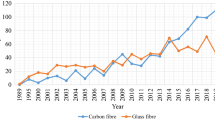Abstract
Representatives of the same species of microscopic fungi developed on composite materials with similar polymeric matrices independently from the type of soils, in which the incubation was performed. Trichoderma harzianum, Penicillium auranthiogriseum, and Clonostachys solani were isolated from the samples of polyurethane. Fusarium solani, Clonostachys rosea, and Trichoderma harzianum predominated on the surface of ultrathene samples. Ulocladium botrytis, Penicillium auranthiogriseum, and Fusarium solani predominated in the variants with polyamide. Trichoderma harzianum, Penicillium chrysogenum, Aspergillus ochraceus, and Acremonium strictum were isolated from Lentex-based composite materials. Mucor circinelloides, Trichoderma harzianum, and Penicillium auranthiogriseum were isolated from composite materials based on polyvinyl alcohol. Electron microscopy demonstrated changes in the structure of polymer surface (loosening and an increase in porosity) under the impact of fungi. The physicochemical properties of polymers, including their strength, also changed. The following substances were identified as primary products of the destruction of composite materials: stearic acid for polyurethane-based materials; imide of dithiocarbonic acid and 1-nonadecen in variants with ultrathene; and tetraaminopyrimidine and isocyanatodecan in variants with polyamide. N,N-dimethyldodecan amide, 2-methyloximundecanon and 2-nonacosane were identified for composites on the base of Lentex A4-1. Allyl methyl sulfide and imide of dithiocarbonic acid were found in variants with the samples of composites based on polyvinyl alcohol. The identified primary products of the destruction of composite materials belong to nontoxic compounds.
Similar content being viewed by others
References
T. V. Aristovskaya, Microbiology of Podzolic Soils (Nauka, Moscow, 1965) [in Russian].
V. I. Bilai, Fuzaria (Naukova Dumka, Kiev, 1977) [in Russian].
V. I. Bilai, I. A. Ellanskaya, and T. E. Kirilenko, Soil Micromycetes, Ed. by V. I. Bilai (Naukova Dumka, Kiev, 1984) [in Russian].
G. Ya. Vorob’eva, Chemical Stability of Polymeric Materials (Khimiya, Moscow, 1981) [in Russian].
GOST (State Standard) 14236-81: Polymer Films. Tensile Strength Test Method.
T. G. Dobrovol’skaya, Structure of Soil Bacterial Communities (Akademkniga, Moscow, 2002) [in Russian].
D. G. Zvyagintsev, Soil and Microorganisms (Mosk. Gos. Univ., Moscow, 1987) [in Russian].
Yu. S. Zuev, Degradation of Polymers under Aggressive Environments (Khimiya, Moscow, 1972) [in Russian].
I. I. Lazarev, Harmful Substances in the Industry (Khimiya, Moscow, 1989) [in Russian].
O. A. Legon’kova, “Methods of Biodegradation Assessment,” Vtor. Resur., No. 5, 41–45 (2005).
O. A. Legon’kova and A. A. Bokarev, “Physicomechanical and Rheological Properties of Composite Materials with Organic and Inorganic Fillers,” Zh. Prikl. Khim. 78(9), 15–21 (2005).
O. A. Legon’kova and L. A. Sukhareva, One Thousand and One Polymers, from Biostable to Biodegradable Ones) (Nauka, Moscow, 2004) [in Russian].
A. Yu. Lugauskas, A. I. Mikul’skene, and D. Yu. Shlyauzhene, Catalogue of Micromycetes, Destructors of Polymeric Materials, Ed. by M. V. Gorlenko (Nauka, Moscow, 1987) [in Russian].
Methods of Soil Microbiology and Biochemistry, Ed. by D. G. Zvyagintsev (Mosk. Gos. Univ., Moscow, 1991) [in Russian].
A. A. Mil’ko, Guide to Mucoral Fungi (Naukova Dumka, Kiev, 1974) [in Russian].
Yu. V. Moiseev and G. E. Zaikov, Chemical Stability of Polymers under Aggressive Environments (Khimiya, Moscow, 1979) [in Russian].
Russian Patent 2257045.
B. P. Pleshkov, Biochemistry of Agricultural Plants (Kolos, Moscow, 1969) [in Russian].
L. A. Trisvyatskii, Storage of Grain (Agropromizdat, Moscow, 1986) [in Russian].
K. H. Domsch, W. Gams, and T. Anderson, Compendium of Soil Fungi (Academic, London, 1980).
M. A. Klich, Identification of Common Aspergillus Species (ASM, Washington, DC, 2002).
O. A. Legonkova, A. A. Bokarev, and V. S. Ivolgin, “Swelling of the Filled Polymer Compositions,” in Synthesis and Properties of Low- and High-Molecular Compounds: Quantitative Level, Ed. by G. E. Zaikov, I. V. Savenkova and K. Z. Gumargalieva (Nova Science, New York, 2006), pp. 321–327.
G. I. Pitt, A Laboratory Guide to Common Penicillium Species, 2nd ed. (CSIRO, Sydney, 1988).
J. I. Pit, The Genus Penicillium and Its Teleomorphic States Eupenicillium and Talaromyces (Academic, London, 1979).
C. Ramirez, Manual and Atlas of the Penicillia (Elsevier Biomedical, Amsterdam, 1982).
Author information
Authors and Affiliations
Corresponding author
Additional information
Original Russian Text © O.A. Legonkova, O.V. Selitskaya, 2009, published in Pochvovedenie, 2009, No. 1, pp. 71–78.
Rights and permissions
About this article
Cite this article
Legonkova, O.A., Selitskaya, O.V. Microbiological destruction of composite polymeric materials in soils. Eurasian Soil Sc. 42, 62–68 (2009). https://doi.org/10.1134/S1064229309010086
Received:
Published:
Issue Date:
DOI: https://doi.org/10.1134/S1064229309010086




